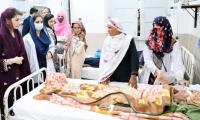The US has the most guns per capita and the weakest gun control laws of any developed country. It is estimated that at least a third of American adults own a gun, and an additional 11 percent live with someone who does. The Pew Research Center reports that for 82 percent of African American adults, gun violence is a very big problem – the largest share of any racial or ethnic group.
Self-defense has been often cited to justify the people’s right to bear arms. Research, however, has shown that a gun kept in a home is much more likely to kill a member of the household or a friend than an intruder. In the US, the number of teenagers who die from gunshot wounds is greater than those who die from all other causes combined.
According to the US Centers for Disease Control and Prevention (CDC), there were 39,707 firearm-related deaths in 2019 in the US, and firearm-related injuries were among the five leading causes of death for people ages 1-64 in the country. In addition, the economic impact of gun violence is substantial. It costs the government $280 billion annually on medical care and lost productivity.
Although many Americans claim that guns are necessary for security, experiences in countries such as Japan prove the fallacy of this argument. In Japan, people who purchase guns have strict background checks. They include a mental health assessment performed at a hospital, checking for evidence of drug use, and the opinion about the applicant by a relative or a colleague. As result, there are less than 100 fatalities for a population of 128 million annually.
Americans are exposed to violence since they are children. It is estimated that when a child becomes an adult, he will have seen 16,000 assassinations and 200,000 acts of violence in television. Can we be surprised when children try to imitate what they see on television and in the movies? For some of them, violence has become the normal way of solving conflicts.
Gun violence can be prevented by applying public health strategies such as continued surveillance of gun-related death and injuries; identification of risk factors; development and evaluation of interventions to reduce those factors; and institutionalization of successful prevention strategies. In addition, it requires de concerted efforts of all community members including law enforcement and public officials, teachers and school administrators, psychology experts and religious leaders.
Excerpted: ‘It’s Not Only Guns, It’s Also The Culture’
Counterpunch.org
After November 30, it will be impossible for ordinary internet users to access all banned websites, including X
Muslims participated alongside their Hindu fellow villagers and other residents of area
For last eight years, HEC's budget has been virtually stagnant in absolute terms
Home to 14 million people, Lahore has always been celebrated as Pakistan’s historical, culinary, and cultural hub
Partnership between Pakistan and China in media and culture reflects shared commitment to strengthening bilateral...
This article focuses on single error committed by our respected judiciary which haunts me more than I would care to...







